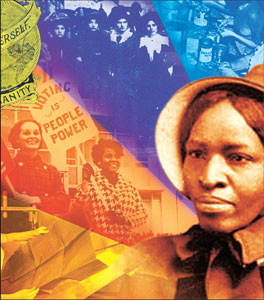|

How the women’s liberation movement came to be what
it is today:
Half the sky: NOT THE SECOND SEX
Aditha Dissanayake
The hour was 5.30 in the morning. The date, sometime in the late
1960s. The place, London. Several women were walking around,
surreptitiously sticking the message “this ad degrades women” on
offensive posters. Fast forward. The time is now 5.30 in the evening.
The stickers and targets have changed in the rush hour traffic. Men in
suits, umbrella tucked under the arm, briefcase swinging, would suddenly
feel the touch of a woman’s hand on their back. A sticker was left
behind. “This man exploits women.”
  These were the early days of the second-wave feminist movement in
Britain. (The first wave was the suffrage campaign). A time of enormous
innocence, enthusiasm and creative power, when small groups of women
were gathering across Britain and the USA, talking about their
circumstances, and feeling the rush of recognition as they realized they
weren’t alone in their frustrations. These were the early days of the second-wave feminist movement in
Britain. (The first wave was the suffrage campaign). A time of enormous
innocence, enthusiasm and creative power, when small groups of women
were gathering across Britain and the USA, talking about their
circumstances, and feeling the rush of recognition as they realized they
weren’t alone in their frustrations.
The talk at these gatherings would always focus on such facts as
“women were very low paid. That they were expected to become either a
nurse or a secretary. That most women were cleaners. Women were too
poor. etc”
Yet, feminist organizing had first raised its head way back in the
early 19th century. William Thompson, a remarkable defender of people
whose interests were not his own, published an Appeal on behalf of one
half of the human race, women, against the pretensions of the other
half, men, to retain them in political and thence in civil and domestic
slavery in 1825. Defending women with a rare passion, he admitted he was
very conscious that he does not share the oppression known to women,
directly.
“Though I do not feel like you-thanks to the chance of having been
born a man ... though I am free from personal interest in this question;
yet can I not be inaccessible to the plain facts and reason of the
case.’ he questioned. Several years later,Charlotte Brontë in her novel,
‘Shirley ‘ had the heroine longing for a trade - even if it made her
coarse and masculine-instead of the vacant, weary, lonely life of a
woman of her class.
Though the phrase women’s liberation was first published in Simone de
Beauvoir’s influential 1949 essay, The Second Sex, the roots of the
women’s liberation movement reach back much further. Ever since men have
claimed dominance over women in patriarchal societies, there have been
strong women who have fought for dignity and human rights.
At various times in history, these women have banded together to form
feminist social movements, such as those that arose at the end of the
eighteenth and nineteenth centuries and during the 1920s and 1940s.
These movements were often followed by backlash periods of increased
suppression of women. Such a period of suppression occurred during the
1950s, which in turn inspired a new period of female rebellion that
began in the 1960s.
This latter rebellion constitutes the largest and most widely
publicized social movement of women in history. It affected women of all
races and classes around the world.
The first stirrings of this awakening was found in etty Friedan’s
groundbreaking book, “The Feminine Mystique”.
Explaining what was wrong with the lives of apparently comfortable
and economically secure women Friedan brought out into the public “the
problem that has no name” -and then to give it a name. Until then, apart
from the Nineteenth Amendment, which gave women the right to vote, there
were no laws against gender discrimination as such in the USA. The word
“sexism,” in its current meaning, did not exist. Not surprisingly
therefore, for many women, the publication of Friedan’s book was one of
those events which seem, in retrospect, to have divided the sixties from
the fifties as the day from the night.
By the early 1970s, the women’s liberation movement had expanded with
energy and excitement. Women started women’s centers, women’s health
clinics, rape crisis centers, and bookstores.
 They formed political groups that published feminist political
writings. Bread and Roses in Boston took over a building on the Harvard
campus where they set up a day care center and taught classes for ten
days before being forced out. They used money that they collected from
supporters to open one of the longest running women’s centers in the
United States. In 1969, Cornell University in Ithaca, New York became
the first college to offer accredited Women’s Studies courses. They formed political groups that published feminist political
writings. Bread and Roses in Boston took over a building on the Harvard
campus where they set up a day care center and taught classes for ten
days before being forced out. They used money that they collected from
supporters to open one of the longest running women’s centers in the
United States. In 1969, Cornell University in Ithaca, New York became
the first college to offer accredited Women’s Studies courses.
In 1966, at the Third Annual Conference on the Status of Women in
Washington, D. C., a group of 28 women formed an organization to fight
for women’s rights. They called it the National Organization for Women
(NOW). By the end of the year, NOW had 300 members; by the end of the
century it would have half a million.
Through mainstream organizations such as NOW, women began to demand
changes in discriminatory laws, But women’s liberation encompassed far
more than the quest for legal rights.
Women began to seek freedom, respect, and the right to an individual
identity and a fulfilled life. No longer satisfied to define themselves
in terms of husbands and families, these women performed the most
radical act of all: they began to talk to each other.
Using a technique called “consciousness raising,” women began to meet
and talk about their lives. In these groups, women found that problems
they had thought were individual, were in fact, shared by many other
women. They also began to think that these personal problems could be
solved only by changing society. This idea gave rise to one of the most
important slogans of the 1960s women’s liberation movement, “The
personal is political.”
Traditional role rejected
The new feminists rejected the traditional role that had been imposed
upon women of the 1950s. In one of the most famous actions of the
women’s liberation movement, in 1968, a hundred women gathered to
protest the shallow values of the Miss America pageant. Into a trashcan,
they threw symbols of the sexual objectification of women such as bras,
girdles, and make-up.
Though nothing was burned, the media seized on the event, and
feminists were “bra-burners” ever after.
As the years went by the movement started to change. Thus, the
feminists of the 1990s and after are conventionally referred to as the
“Third Wave.”
These are women who recognized the way in which earlier feminism had
been blind to the femininity of Blacks, working class and other women,
and developed a much more general, reflexive analysis of status
subordination.
As a result, while men, from government officials to radical
leftists, trivialized women’s issues, by talking together women began to
construct a political analysis of a sexist society that encompassed the
government, the educational system, the media, religion, the family, and
even the language.
In spite of the attempts of the Anti-feminists to trivialize the
movement, calling feminists humorless and strident, the movement lives
on, both in the work of older feminists who never stopped working to
address the issues of sexism, and in the younger women who continue to
be inspired by the courage and dedication of generations of women who
fought for liberation.
In the end, everything boils down to power. As Mary Wollstonecraft,
the ‘first feminist’ said let’s not wish women to have power over men,
but over themselves.
[email protected]
|





